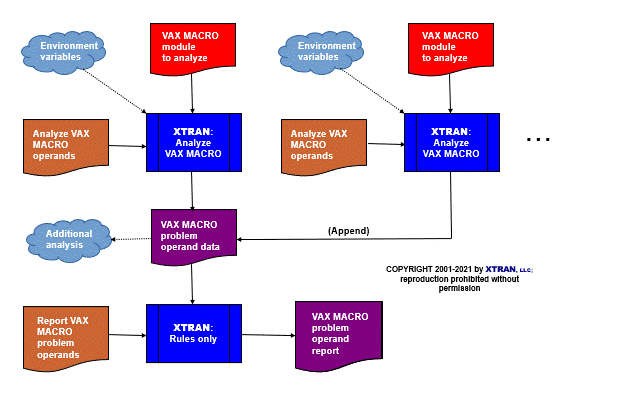XTRAN Example — Analyze HP (Digital, Compaq) VAX MACRO Problem Operands
In translating VAX MACRO to C, a number of types of assembler operands can cause problems. These include:
- Numeric offsets to registers
- Expression offsets to registers
- Expression addresses
- Program counter (
.) references - Names that are not declared, so XTRAN can't determine whether they are addresses or values
The following example identifies and reports all of the above problems. It uses standard rule sets that we deliver with our VAX MACRO analysis version of XTRAN. The analysis and reporting rules comprise about 600 non-comment lines of XTRAN's rules language, which we call "meta-code".
The procedure is to run the operand analysis on all source files, appending the results to a single text data file. When all modules have been analyzed, a final XTRAN run is done with a set of reporting rules that reads the text data file and generates the analysis output.
The analysis output shows all occurrences of each instance of each of the problems specified above, in all analyzed source files. (In the example below, we analyzed only one source file.)
XTRAN has the ability to handle numeric and
expression offsets and expression addresses automatically, by generating
appropriate address arithmetic in C. However, the tradeoff is C code that
is less readable and not as easily maintained. So it is usually better to
identify the problems and fix them than to let XTRAN
translate them. Once they have been identified by an analysis such as
this one, and suitable fixes have been
determined, XTRAN has facilities to automate the
cleanup as part of the translation process.
Click ![]()
![]() for an actual
translation example using this technique.
for an actual
translation example using this technique.
The input to and output from XTRAN are untouched, except that line numbers have been added to the input for reference.
Process Flowchart
Here is a flowchart for this process, in which the elements are color coded:
- BLUE for XTRAN versions (runnable programs)
- ORANGE for XTRAN rules (text files)
- RED for
code - PURPLE for text data files

Input to XTRAN: deman4-a.mar
44 A = 1 45 B = 2 46 MOVL A+1(R2),2(R3) ;expr offset, num offset 47 MOVL UNKN(R1),R2 ;ambig opnd 48 MOVL WS+2,R2 ;expr addr 49 C = . ;parsed as "C:" 50 MOVL A+1(R2),4(R3) ;expr offset, num offset 51 MOVL WS+2,R2 ;expr addr 52 MOVL A+2(R2),2(R3) ;expr offset, num offset 53 MOVL WS+2,R2 ;expr addr 54 BRW .+4 ;PC occurrence 55 MOVL A+1(R2),2(R3) ;expr offset, num offset 56 MOVL WS+4,R2 ;expr addr 57 . = 1000 ;PC occurrence 58 MOVL #WS+4,R2 ;expr addr 59 MOVL UNKN(R1),R2 ;ambig opnd 60 WS: .BLKW 1
Output from XTRAN:
Total of 2 numbers as offsets:
2 (3):
deman4-a.mar . . . . . . . 46, 52, 55
4 (1):
deman4-a.mar . . . . . . . 49
Total of 2 expressions as offsets:
A+1 (3):
deman4-a.mar . . . . . . . 46, 49, 55
A+2 (1):
deman4-a.mar . . . . . . . 52
Total of 2 expressions as addresses:
WS+2 (3):
deman4-a.mar . . . . . . . 48, 51, 53
WS+4 (2):
deman4-a.mar . . . . . . . 56, 58
Total of 1 ambiguous operand:
UNKN(R1) (2):
deman4-a.mar . . . . . . . 47, 59
Program Counter references:
. (1):
deman4-a.mar . . . . . . . 57